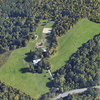Guilderland solar proposal raises concerns in New Scotland
NEW SCOTLAND — The largest solar proposal Guilderland has yet to see would be accessible only from New Scotland, a fact that has led New Scotland to scrutinize the project more closely.
Borrego Solar Systems is seeking to install an 8.84-megawatt large-scale, ground-mounted, solar array on about 87 acres of land owned by JL Development that straddles Guilderland and New Scotland.
Nearly 59 acres are in Guilderland, which is where the entire solar array would be located; the remaining acreage is in New Scotland. On the New Scotland portion of the parcel, Borrego Solar is looking to install a 200-foot-long driveway, the utility infrastructure, and to upgrade an existing driveway on the site, James Kondrat, a project developer with the company, told the town’s planning board in May.
The project’s address is listed as 6120 Johnston Road Rear in Guilderland but the site can only be accessed from Krumkill Road in New Scotland.
The proposal is currently before the Guilderland Zoning Board of Appeals, the lead agency on the project.
After Guilderland sent the project to New Scotland for comment, it was decided that a full application to the planning board would be necessary.
A cluster subdivision had previously been proposed for the site, but the owner hasn’t been able to get that project off the ground because of an inability to connect to the town of Bethlehem’s water system, Kondrat said.
First brought before the New Scotland Planning Board in November 2018 as a 22-lot conventional subdivision, the planning board, citing development recommendations made by the town’s recently-adopted comprehensive land-use plan, asked the developer, Prime Companies, consider a cluster development, which, according to Charles Voss, the planning board’s chairman, made “the development fit the existing conditions of the land ….”
To preserve open space, clustering means smaller lot sizes, which meant community septic, which led to skepticism from the town board.
Under the initial 22-lot proposal, each home sat on a 30,000-square-foot parcel of land that was large enough to accommodate a septic system; the clustered lot sizes were closer to 20,000 square feet each. The proposed community septic system was, in effect, a giant version of a home system. Sewer lines would be run from each home to four septic tanks and a leach field located at the entrance to the subdivision.
But the subdivision proposal has now been formally withdrawn, Kondrat said. Another developer had tried to develop the land about 15 years ago but ran into the same sewer-and-water problems, Kondrat said. “History would tell us it would seem unlikely,” he said of future development on the land.
Even though the owner withdrew the subdivision application, the way the solar proposal is configured in New Scotland, it wouldn’t preclude the landowner from coming back before the board with another development proposal, Voss said at the May meeting.
Planning board attorney Crystal Peck said when the town met with Borrego Solar, issues related to the State Environmental Quality Review Act and the segmentation of the review process were raised. There had to be a “full review,” Peck said. “You’re not supposed to segment it.” There were development plans for part of the 87-acre site, she said, yet “it is all one parcel.”
The town got a letter from the developer withdrawing the application, but Peck had some concerns with the phrasing of the letter.
Reading a portion of the letter, Peck said, “I have been working with Borrego solar to ensure, in the event the cluster design becomes a reality in the future, the design intent of the cluster we work so hard on does not go to waste.”
She then said to the board, “That last sentence does cause me concern because what it’s doing is it’s withdrawing but it’s still saying we plan to develop and plan to develop on a cluster.”
Peck said there had been internal discussion about the viability of a cluster subdivision on the site given that the application has been pending for some time now. And because of the water-and-sewer issues, “at least on a residential capacity,” it wasn’t thought the site was right for development.
There was another issue: Whose land is it.
Building Inspector Jeremy Cramer said, “There’s an issue that the town of New Scotland and the town of Bethlehem have been very aware of for the last 15 plus years.”
The two towns need to work together to come up with “a definitive municipal border,” Cramer said. “That way the engineering can be designed around where that border is agreed upon … That we can move forward with a water or sewer or whatever type of system — or district, I should say — in that area.”
Voss asked about creating separate lots for the solar proposal, one in Guilderland and one in New Scotland, which would “keep it a little cleaner in terms of a SEQR review,” because the town is aware of the development that could happen down the road.
There’s been no movement on the cluster development application since November 2018.
Although a glare study looked at issues from the Guilderland side of the project, the planning board felt more needed to be done to address issues on the New Scotland side.
And given the new driveway and utility equipment that would be installed on its portion of the parcel, the planning board wanted New Scotland to be part of the Guilderland-Borrego solar facility decommission agreement.


